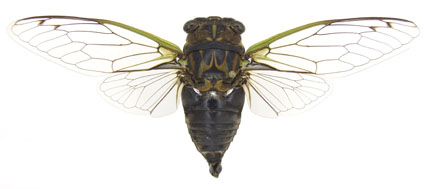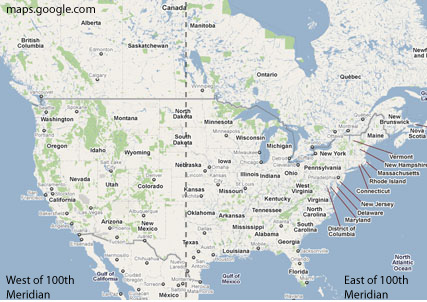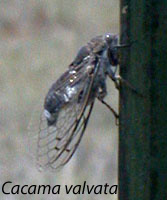
East of the 100th Meridian

Neotibicen similaris apalachicola
** RECORDINGS AND IMAGES MAY NOT BE REPRODUCED ELSEWHERE. SEE THE COPYRIGHT SECTION **
This website provides song recordings of the cicadas of the eastern United States and Canada, approximately 65 described species and subspecies (Family Cicadidae). Cicada songs are loud and complex, and they are made by males to attract females for mating. These sounds are nearly always species-specific, and they provide the most reliable means of identifying most species. The 100th meridian, which runs north-south through the western parts of the Great Plains states, is used here as a cutoff between eastern and western states since it approximates the region where divergent eastern and western faunas meet. Approximately 110 additional cicada species are found only in the western states, mainly in the genera Platypedia and Okanagana – song recordings of 30 of these species, mainly from the southwestern US, are included on the Western Cicada Species page.

Eventually, photographs of the species will be included, along with general distribution maps. For now, the site emphasizes the song data. Detailed maps based on museum specimens can be found in the open-access research article by Sanborn and Phillips (2013), and additional information is available using the online database at Cicada Central. General information on cicada ecology and behavior is readily available through the many cicada-related websites mentioned at the end of this page.
For now, the sounds are provided in MP3 format. If you have problems, try a different web browser first.
The species are listed below by subfamily and then by genus. We began with Neotibicen because they're our favorites! Author and date information are given for all taxonomic names. References can be found at the comprehensive Bibliography of the Cicadoidea website.
A NOTE ON CLASSIFICATION
The family-level classification used here follows the revision of Marshall et al., (2018), which accompanied the first molecular phylogeny of the cicadas. North American genera affected by the changes include Diceroprocta, Magicicada, and Quesada.
A NOTE ON NOMENCLATURE
Recent New Genera - In 2015, all of the North American species formerly assigned to the genus Tibicen Latreille, 1825 were moved to one of two new genera, Neotibicen Hill and Moulds and Hadoa Moulds, following molecular phylogenetic analysis of the tribe showing that the North American species are not related to the type species of Tibicen, T. plebejus (a species from Europe, often referenced under the genus Lyristes). Subsequently, some of those species were moved to new genera by Sanborn and Heath 2016 (Megatibicen) and by Lee 2016 (Ameritibicen, Gigatibicen, Paratibicen), although there is continuing debate about how many additional genera to use (see also Marshall and Hill 2017) p. 531.
Gender Agreement - Genera and species names are Latinized and so the words have genders (masculine, neuter or feminine, as in all Romance Languages). By the rules of nomenclature, the gender of the genus and species must agree in certain cases. Thus, the ending of a species epithet (the second part of a species' name) can shift gender when species are moved between genera. So if you don't see the name you're looking for, (e.g., Neotibicen pruinosa, species epithet feminine), look for an alternative ending (pruinosus, which agrees with the masculine Neotibicen). Similarly, a species may be located under a different genus name than expected – Melampsalta calliope, for example, is currently Cicadettana calliope. We have included widely-recognized older names in a few cases so searching on them within the page may be useful.
A CALL FOR DISTRIBUTION INFORMATION
One purpose of this website is to increase awareness of the different species and their approximate distributions in order to generate new data. We are interested to hear about significant range extensions if they are backed up with a well-documented specimen (with accurate locality, date, and collector information) or recording. Even a cell-phone recording of a cicada can be sufficient to identify a species. Again, detailed information for each of the species is available using the research paper at this link.
Many USA species from this subfamily have recently been transferred from the genus Tibicen (see also here, here, and here).
SUBFAMILY
CICADINAE Latreille, 1802
Cicadas of the subfamily Cicadinae tend toward large size and loud,
complex songs, often with complex frequency harmonics. Some species, such as many from the genus Neotibicen, sing
distinct song phrases, while other species (especially in Diceroprocta) sing
monotonous, continuous songs. Pair-formation is variable, with males
almost entirely stationary in some species (especially Diceroprocta, Beameria)
and highly mobile (alternating song bouts with flight) in others.
Genus Cacama Distant, 1904
|
 |
SPECIES |
SONG (MP3 - CLICK LINK) |
PHOTOS NOT READY YET | MAPS NOT READY YET | COMMENTS |
Cacama collinaplaga Sanborn and Heath, 2011
|
 |
 |
|
|
Cacama valvata (Uhler, 1888) |
 |
 |
|
|
Cacama variegata Davis, 1919 |
|
 |
 |
|
Genus Megatibicen Sanborn and Heath, 2016
|
 |
SPECIES |
SONG (MP3 - CLICK LINK) |
PHOTOS NOT READY YET | MAPS NOT READY YET | COMMENTS |
Megatibicen auletes (Germar, 1834)
|
 |
 |
|
|
Megatibicen dealbatus (Davis, 1915) |
 |
 |
|
|
Megatibicen dorsatus (Say, 1825) |
 |
 |
|
|
Megatibicen figuratus (Walker, 1858) |
 |
 |
|
|
Megatibicen harenosus Cole, 2017 |
 |
 |
|
|
Megatibicen pronotalis pronotalis (Davis, 1938) |
 |
 |
|
|
Megatibicen pronotalis walkeri (Metcalf, 1955) |
 |
 |
|
|
Megatibicen resh (Haldeman, 1852) |
 |
 |
|
|
Megatibicen resonans (Walker, 1850) |
 |
 |
|
|
Megatibicen tremulus (Cole, 2008) |
 |
 |
|
Genus Neotibicen Hill and Moulds, 2015
|
   |
SPECIES |
SONG (MP3 - CLICK LINK) |
PHOTOS NOT READY YET | MAPS NOT READY YET | COMMENTS |
Neotibicen auriferus (Say, 1825) |
 |
 |
|
|
Neotibicen canicularis (Harris, 1841) |
 |
 |
|
|
Neotibicen davisi davisi (Smith and Grosbeck, 1907) |
 |
 |
|
|
Neotibicen davisi harnedi (Davis, 1918) |
 |
 |
|
|
Neotibicen latifasciatus (Davis, 1915) |
 |
 |
|
|
Neotibicen linnei (Smith and Grosbeck, 1907) |
 |
 |
|
|
Neotibicen lyricen lyricen (De Geer, 1773) |
 |
 |
|
|
Neotibicen lyricen virescens (Davis, 1935) |
 |
 |
|
|
Neotibicen pruinosus (Say, 1925) |
 |
 |
|
|
Neotibicen robinsonianus (Davis, 1922) |
 |
 |
|
|
Neotibicen similaris similaris (Smith and Grosbeck, 1907) |
 |
Click here for distribution map |
||
Neotibicen similaris apalachicola Marshall and Hill, 2017 |
 |
Click here for distribution map |
||
Neotibicen superbus (Fitch, 1855) |
 |
 |
|
|
Neotibicen tibicen australis (Davis, 1912) |
 |
 |
|
|
Neotibicen tibicen tibicen (Linnaeus, 1758) (= Thopha chloromera Walker, 1850) |
 |
 |
|
|
Neotibicen winnemanna (Davis, 1912) |
 |
 |
|
Genus Hadoa Moulds, 2015
|
SPECIES |
SONG (MP3 - CLICK LINK) |
PHOTOS NOT READY YET | MAPS NOT READY YET | COMMENTS |
Hadoa texana (Metcalf, 1963) (=Tibicen tigrinus Davis, 1927) |
 |
 |
|
Genus Diceroprocta Stål, 1870
|
   |
SPECIES |
SONG (MP3 - CLICK LINK) |
PHOTOS NOT READY YET | MAPS NOT READY YET | COMMENTS |
Diceroprocta aurantiaca Davis, 1938 |
 |
 |
|
|
Diceroprocta averyi Davis, 1941 |
 |
 |
|
|
Diceroprocta azteca (Kirkaldy, 1881) |
 |
 |
|
|
Diceroprocta bequaerti (Davis, 1917) |
|
 |
 |
|
Diceroprocta biconica (Walker, 1850) |
 |
 |
|
|
Diceroprocta cinctifera (Uhler, 1892) |
SONG |  |
 |
|
Diceroprocta delicata (Osborn, 1906) |
 |
 |
|
|
Diceroprocta eugraphica (Davis, 1916) |
 |
 |
|
|
Diceroprocta olympusa (Walker, 1850) |
 |
 |
|
|
Diceroprocta marevagans Davis, 1928 |
 |
 |
|
|
Diceroprocta texana texana (Davis, 1916) |
 |
 |
|
|
Diceroprocta viridifascia (Walker, 1850) |
 |
 |
|
|
Diceroprocta vitripennis (Say, 1830) |
 |
 |
|
Genus Neocicada Kato, 1932
|
 |
SPECIES |
SONG (MP3 - CLICK LINK) |
PHOTOS NOT READY YET | MAPS NOT READY YET | COMMENTS |
Neocicada hieroglyphica hieroglyphica (Say, 1830) |
 |
 |
|
|
Neocicada hieroglyphica johannis (Walker, 1850) |
POSSIBLE |
 |
 |
|
Genus Pacarina Distant, 1905
|
  |
SPECIES |
SONG (MP3 - CLICK LINK) |
PHOTOS NOT READY YET | MAPS NOT READY YET | COMMENTS |
Pacarina puella Davis, 1923 (= "Cicada signifera" Walker 1858) |
 |
 |
|
Genus Beameria Davis, 1934
|
  |
SPECIES |
SONG (MP3 - CLICK LINK) |
PHOTOS NOT READY YET | MAPS NOT READY YET | COMMENTS |
Beameria venosa (Uhler, 1888) |
 |
 |
|
Genus Quesada Distant, 1905
|
  |
SPECIES |
SONG (MP3 - CLICK LINK) |
PHOTOS NOT READY YET | MAPS NOT READY YET | COMMENTS |
Quesada gigas (Olivier, 1790) |
 |
 |
|
SUBFAMILY TETTIGADINAE Distant, 1905
The subfamily Tettigadinae is well-represented in North America, with seven genera together containing the lion's share of our cicada species. Only a small fraction of these species reach the eastern region and all belong to the genus Okanagana. Some Tettigadinae species in the Western states (in the genera Platypedia and Neoplatypedia) have lost their timbals and communicate entirely by wing-banging.
Genus Okanagana Distant, 1905
|
  |
SPECIES |
SONG (MP3 - CLICK LINK) |
PHOTOS NOT READY YET | MAPS NOT READY YET | COMMENTS |
Okanagana balli Davis 1919 |
 |
 |
|
|
Okanagana canadensis (Provancher, 1889) |
 |
 |
|
|
Okanagana hesperia (Uhler, 1876) |
 |
 |
|
|
Okanagana noveboracensis (Emmons 1854) |
 |
 |
|
|
Okanagana rimosa ohioensis Davis, 1942 |
 |
 |
|
|
Okanagana rimosa rimosa (Say, 1830) |
 |
 |
|
|
Okanagana synodica (Say, 1825) |
 |
 |
|
|
Okanagana viridis Davis, 1918 |
 |
 |
|
SUBFAMILY CICADETTINAE Buckton, 1809
All North American cicadas of the subfamily Cicadettinae are medium-sized
to small, and all possess a pair-forming system in which males
alternate short song bouts with short flights. Songs are often high-pitched and contain broad-spectrum, "clicky" or "buzzy" sound.
Genus Cicadettana Marshall & Hill, 2017
|
  |
SPECIES |
SONG (MP3 - CLICK LINK) |
PHOTOS NOT READY YET | MAPS NOT READY YET | COMMENTS |
Cicadettana calliope calliope (Walker, 1850) |
 |
 |
|
|
Cicadettana calliope floridensis (Davis, 1920) |
|
 |
 |
|
Cicadettana camerona (Davis, 1920) |
 |
 |
|
|
Cicadettana kansa (Davis, 1919) |
 |
 |
|
|
Cicadettana texana (Davis, 1936) |
 |
 |
|
Genus Magicicada Davis, 1925
|
 |
** Please report observations on Magicicada emergences to Cicadas.uconn.edu. **
SPECIES |
SONG (MP3 - CLICK LINK) |
COMMENTS |
Magicicada cassini (Fisher, 1851) |
|
|
Magicicada neotredecim Marshall and Cooley 2000 |
|
|
Magicicada septendecim (Linnaeus, 1758) |
|
|
Magicicada septendecula Alexander and Moore, 1962 |
|
|
Magicicada tredecassini Alexander and Moore, 1962 |
|
|
Magicicada tredecim (Walsh and Riley, 1868) |
|
|
Magicicada tredecula Alexander and Moore, 1962 |
|
Methods Notes
The recordings on this page were made by the authors using a variety of digital audio recorders (e.g., SONY TCD-D8 DAT, Marantz PMD 660, 670, or 680 compact flash models) sampling at either 44.1 or 48 kHz. Microphones used were Sennheiser ME62 omnidirectional microphones installed in SONY PBR-330 parabolic reflectors, or similar-quality Sennheiser short- and long-gun shotgun mikes with no parabola. (Note that parabolic reflectors introduce small "pre-click" artifacts because sound waves are recorded twice, once weakly as they arrive and then again after reflection, but these are noticeable only during very fine-scale analysis.) Files were processed (e.g., filtering) using Canary or RavenPro v1.4 software (Cornell Bioacoustics) on Macintosh G3, G4 and intel computers, and the 128 Mbps, constant-bitrate MP3 files were generated using open-source Audacity 1.3.12-beta software.
These examples have been selected because they represent the typical song behavior as well as possible given what we have in our archives.
Most of the recordings have been filtered to remove sound below around 4 kHz, where most automobile, wind, and other environmental noise is found. In a few cases frequencies higher than those of the target cicada have been removed, for example when a loud katydid overlapped the song of the target. Some of the recordings have a "tinny" feel as a result of this filtering.
Many of the sound files have also been modified with "fade in" and "fade out" effects, especially when the song of the cicada is not structured into distinct phrases.
Other Websites on Cicadas and Singing Insects
Cicadamania – the oldest and best-known general website for cicada enthusiasts.
Cicadas.uconn.edu – solicits and organizes distribution records for periodical cicada broods from the public.
Cicada Central – established as a clearinghouse for research on world Cicadidae.
New Zealand Cicadas: A Virtual Identification Guide – comprehensive information on the New Zealand species.
Cicadas of Australia – an extensive website on Australian cicadas, with songs, photos, maps, and natural history.
The Canadian National Collection of Insects – general cicada identification plus information on morphology, ecology, and evolution.
Cicadasong.eu – songs and other content on European cicadas.
Cicadas of India – a major new addition with over 100 species pages.
Cicadidae in Japan – includes a database form for accessing songs of Japanese and Korean cicadas.
Slovenian Wildlife Sound Archive – from the Slovenian Museum of Natural History.
S.E. Asian Cicada Songs – from the Slovenian Museum of Natural History.
Cicada Songs from Borneo – with sonograms and some phenological data.
Checklist of South African Cicadas – from the Villet Lab, Rhodes University.
Great Lakes Cicada Page – by the author of a new book "The Season of the Cicada".
Cicadas.info – focuses on cicadas of the mid-Atlantic states.
Cicadas of Massachusetts – extensive site on New England cicadas, collecting techniques, etc.
Cicadas of Michigan – focuses on Michigan cicadas with songs and identification keys.
Cicadas of Florida – basic taxonomy, identification, and life history.
Cicada Checklist of Texas – includes detailed information on Quesada gigas
University of Michigan Periodical Cicada Site – older comprehensive site on periodical cicadas.
BugGuide.net – a general insect identification site with many cicada photos; some photo IDs may not be correct.
Songs of Insects – a companion website for a book of the same name, contains an online identification guide for songs.
Singing Insects of North America – an extensive general resource with songs, maps, and keys. Cicada section under development.
Bibliography of the Cicadoidea – a web database of scientific publications on cicadas.
The sound and image files linked on this site are for personal, not-for-profit viewing and listening only and must not be duplicated, sold, or reproduced elsewhere without written permission from David Marshall [cicada "at" insectsingers.com]; Nonetheless, we're usually happy to oblige requests for educational purposes and limited use in other projects.
Credits and Acknowledgments
Website constructed by David C. Marshall and Kathy Hill, researchers at the University of Connecticut in the lab of Chris Simon. This research has benefited from substantial synergistic support under NSF grants DEB 04-22386, DEB 05-29679, and DEB 07-20664 to Chris Simon and from discussions with many cicada enthusiasts and collaborators.
Back to InsectSingers.com